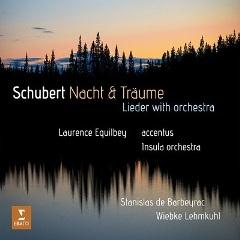Schubert - Nacht & Träume Lieder with orchestra (2017)
Schubert - Nacht & Träume Lieder with orchestra (2017)

01. Schwanengesang, D. 957: IV. Ständchen (Orch. Mottl) 02. An Sylvia, D. 891 (Orch. Krawczyk) 03. Die Forelle, D. 550 (Orch. Britten) 04. Ganymed, D. 544 (Orch. Richard Strauss) 05. Im Abendrot, D. 799 (Orch. Reger) 06. Nacht und Träume, D. 827 (Orch. Krawczyk) 07. Die junge Nonne, D. 828 (Orch. Liszt) 08. Gruppe aus dem Tartarus, D. 583 (Orch. Brahms) 09. Rosamunde, D. 797: V. Entr'acte 3 10. Rosamunde, D. 797: IIIb. Der Vollmond strahlt auf Bergeshöh'n 11. Gondelfahrer, D. 809 (Orch. Krawczyk) 12. Coronach, D. 836 (Orch. Krawczyk) 13. Erlkönig, D. 328 (Orch. Berlioz) 14. Das Grab, D. 377 (Orch. Krawczyk) 15. Du bist die Ruh, D. 776 (Orch. Webern) Insula orchestra Wiebke Lehmkuhl - mezzo-soprano (2, 7, 8, 10) Stanislas de Barbeyrac - tenor (1, 3–6, 13, 15) Accentus (11, 12, 14) Laurence Equilbey - conductor
Nacht und Träume takes its name from one of Schubert’s best-loved lieder, which is joined on the album by a further 10 of the composer’s songs. All performed in orchestral versions by such masters as Berlioz, Liszt, Brahms, Strauss, Webern, Britten and Schubert himself, they are complemented by three choral numbers and an orchestral interlude. The singers are rising stars – German mezzo-soprano Wiebke Lehmkuhl and French tenor Stanislas de Barbeyrac – and Laurence Equilbey conducts two ensembles she founded: the Insula orchestra and the choir accentus. ---warnerclassics.com
The French conductor Laurence Equilbey has specialized in radical recontextualization of classical repertory standards with her choir Accentus, producing such novelties as a texted version of the Adagietto movement from Mahler's Symphony No. 5. This group of orchestral versions of Schubert songs might seem to be more of the same, but in fact this release is a bit less radical: most of the transcriptions here are from the 19th and early 20th centuries, although a few, by Franck Krawczyk, are contemporary. The latter occur toward the end of the program and include Accentus, but mostly these are solo orchestral songs, and the orchestrators include such familiar names as Britten, Strauss, Reger (who wrote a lot of these, although Equilbey disparages most of them), Webern, Brahms, and Berlioz, whose version of Erlkönig ought to be more familiar than it is. Equilbey picks the songs well, avoiding the truly intimate, lyric Goethe settings and gravitating toward already potentially operatic songs like the Brahms Gruppe aus dem Tartarus, D. 583. It's not entirely clear why so many of these orchestrations were made for Schubert, seemingly more often than for other composers; perhaps it was simply the ongoing fascination among the Romantics regarding this short-lived wonder. The arrangements work well, and the period 19th century instruments of the Insula Orchestra, playing at A = 438 hz, add the right balances. One could wish that mezzo-soprano Wiebke Lehmkuhl seemed a little less stressed by the material, but overall this is an intriguing rediscovery of some Schubert-related material, and one that reflects Equilbey's distinctive musical personality. ---James Manheim, AllMusic Review
Album "Nacht und Träume" nawiązuje w nazwie do jednego z najsłynniejszych dzieł Schuberta i zawiera 10 jego najsłynniejszych pieśni.
Wszystkie są tu zaprezentowane w wersjach orkiestrowych opracowanych przez wybitnych twórców muzyki – Berlioza, Liszta, Brahmsa, Straussa, Weberna, Brittena i Schuberta i uzupełnione o interludia.
Wykonawcami są wschodzące gwiazdy muzycznej sceny: niemiecka mezzosopranistka - Wiebke Lehmkuhl, francuski tenor - Stanislas de Barbeyrac, a Laurence Equilbey dyryguje orkiestrą i chórem, które sama założyła. ---empik.com
download (mp3 @320 kbs):
yandex mediafire uloz.to cloudmailru gett








